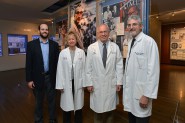Breast cancer patient on a mission to spread info about genetic counseling and testing
Breast cancer is one of the most prevalent forms of cancer worldwide, affecting millions of individuals each year. While it can affect people of all ages and backgrounds, some individuals face a higher risk of developing breast cancer due to various factors, including genetics.
“It is important to be aware if you are at high risk so you can be more on the lookout to catch any cancer as soon as possible,” says Dr. Julie Nangia, medical director of breast oncology at the Dan L Duncan Comprehensive Cancer Center at Baylor College of Medicine.

Rose Montemayor, a breast cancer survivor and Baylor Medicine patient, knows firsthand the importance of early detection and knowing your family history. Her mom passed away from ovarian cancer, so Montemayor had a hysterectomy as a preventive measure. Despite learning she had the BRCA1 and BRCA2 genes that increase the risk of developing breast and ovarian cancers, Montemayor was hesitant to undergo surgery to remove her breasts.
“The doctor at the time recommended a double mastectomy, but I was stubborn,” she remembers. “We don’t listen and are worried about the way we look. If I had just undergone the procedure and done the reconstruction, then I would have avoided other damage to my body from chemotherapy I ended up needing years later, not to mention the mental toll.”
Ten years after her hysterectomy, Montemayor felt discomfort in her right breast when she would move her arm or lay on her side. After having a mammogram, a 3D mammogram and then a biopsy, she was diagnosed with breast cancer. She underwent chemotherapy for about five months and then had a double mastectomy and breast reconstruction.
“In the past, it was a horrible cut, but now there are so many options,” Montemayor says. “For me, my experience was good. You can’t even tell.”
Montemayor felt many effects from chemo – from losing her hair, which she says is very emotionally difficult for women, to nausea, weakness, tiredness, heartburn and losing taste. Because of these negative effects she felt from chemotherapy, Montemayor is now passionate about educating others about the various tests and exams to detect cancer early so they may avoid what she went through.
According to the American Cancer Society, when breast cancer is detected and treated early (in the localized stage), the 5-year survival rate is 90%.
“Early detection is extremely effective in the fight against breast cancer,” says Dr. Pabel Miah, Baylor Medicine breast cancer surgeon. “It’s our best shot at catching the disease when it’s most manageable, giving us the upper hand in treatment and improving our odds of a positive outcome for the patient.”
Like Montemayor experienced, a strong family history of breast, ovarian and pancreatic cancers can significantly increase an individual’s risk of developing breast cancer. The presence of certain genetic mutations, such as BRCA1 and BRCA2, can predispose individuals to these cancers.
Thus, genetic counseling and testing play a pivotal role in identifying high-risk patients. Genetic counselors are trained professionals who assess an individual’s risk based on their family history and other factors. They can recommend genetic testing when appropriate.
At the Dun L Duncan Comprehensive Cancer Center, patients at higher-than-average risk can meet with a certified genetic counselor and oncologist to have a comprehensive review of their medical and family history, genetic counseling and testing if needed and a treatment plan for breast cancer screening and risk reduction.
If you meet any of the criteria below, experts highly recommend that you schedule an appointment for a genetic risk assessment by calling 832-957-6500.
- A family history of ovarian, pancreatic, aggressive prostate or breast cancer diagnosed at age 50 or younger
- Three or more family members with breast cancer
- Family history of any two cancers: ovarian, pancreatic, aggressive prostate or early breast
- Personal or family history of ovarian cancer
- Family history of male breast cancer
- Known genetic mutation in the family
- Ashkenazi Jewish ancestry and personal or family history of breast or ovarian cancer
Additional screening and risk-reducing strategies
For high-risk patients, especially those with genetic mutations, additional screening and risk-reducing strategies can be lifesaving.
- Regular breast cancer screening: High-risk individuals should undergo more frequent and comprehensive breast cancer screenings, including mammograms and MRIs, as recommended by their healthcare providers.
- Ovarian cancer screening: In some cases, individuals who have a BRCA mutation may benefit from the removal of the ovaries or regular screenings, such as transvaginal ultrasounds and CA-125 blood tests.
Learn more about breast cancer.
By Tiffany Harston, communications associate with the Michael E. DeBakey Department of Surgery



